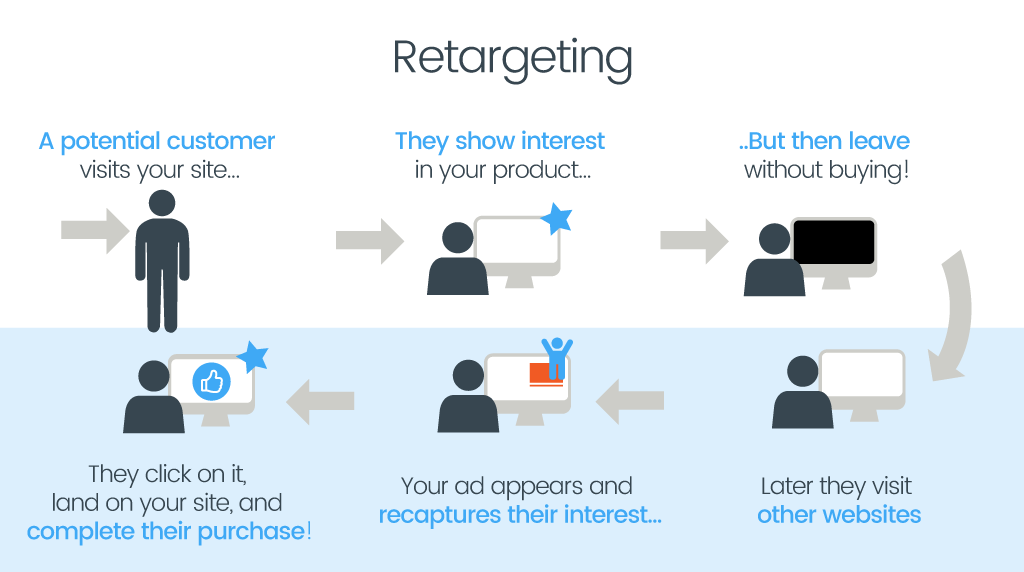It would be wonderful if growing your business was as simple as attracting ideal prospects to your website and converting them to buying customers on their first visit. Then, all the marketing strategies you’d need would be things like SEO, content marketing, and social media. But, according to Marketo, approximately 96% of visitors who come to your website are not ready to buy during their first visit. So, you need a strategy to pursue, attract and capture their lead information by keeping your name in front of them.
That’s where retargeting comes in. It is an advertising strategy allowing you to keep your brand in front of potential customers after they leave your website without buying. It enables you to show these visitors ads related to their activity on your site while they are on other websites. It’s an effective strategy where the click-through rate (CTR) is 10 times that of regular display ads. Plus, website visitors who are retargeted are 70% more likely to convert. With a success rate like that, let’s take a closer look at this strategy.
How retargeting works
Retargeting ads make it possible for you to show specific ads to site visitors who demonstrated an interest in your product based on characteristics like their behavior, time, or frequency on your website. These ads appear while they are on other websites, search engine pages or social media platforms and are enabled by pixels or their email address, depending on the type of campaign.
Why should you use retargeting?
There are many benefits to using retargeting ads. We’ve already established they’re effective. That’s partly because 3 out of 4 consumers notice retargeting display ads. It is also highly targeted based on the specific audience who is already aware of your brand. Plus, it starts being delivered to prospects immediately, if desired. So, it isn’t surprising that their click-through rates are so much higher than regular display ads.

How retargeting ads work
Retargeting vs. Remarketing – what’s the difference?
The terms retargeting and remarketing are often used interchangeably. Although they are similar, they are not the same.
Retargeting involves the use of tracking pixels or cookies and is most often focused on converting new prospects to leads when they fail to act during visits to your website.
Remarketing typically refers to email marketing to leads to advance them through your funnel. There are times when retargeting is a remarketing approach for serving targeted ads to existing leads to encourage them to take the next step with your organization.
Methods of collecting audience data
There are two common methods of gathering audience data for retargeting campaigns to ensure the right prospects see the correct ads. These methods include the use of retargeting pixels and email lists.
Retargeting Pixels
This method of audience development involves the placement of a JavaScript code (a pixel) on your website or landing page. Every time someone visits your website or landing page, the pixel drops an anonymous cookie in the visitor’s browser. This pixel communicates with your remarketing provider when the prospect leaves your website to browse other websites. It results in this potential customer seeing your ads.
Retargeting Lists
When retargeting existing prospects for whom you already have their email address, you can use their email address to trigger specific ads to entice them to take the next step with your brand. For example, if you want a blog subscriber to download a whitepaper or e-book and they’ve been ignoring your invitations to do so on your website. This is also a great way to encourage free subscribers to upgrade to paid subscriptions. These are both excellent candidates for retargeting campaigns.
Campaign goals
When planning a retargeting campaign, it’s important to know what you want to accomplish. There are two common goals for this strategy – awareness and conversion.
Awareness is designed to educate visitors about your product features, announcements, or changes. This goal is best for prospects who have little experience with your brand.
Conversion targets potential customers who are more familiar with your brand or its products and haven’t taken advantage of an offer yet. Your goal is to get them to click on the ad, taking them to a landing page designed to convert them.
Retargeting platforms
There are many platforms or tools available for implementing your retargeting campaigns. AdRoll, Retargeter, and
PerfectAudience are examples of third-party platforms. You can also leverage tools offered by search engines like Google and Bing or social media platforms such as Facebook, Twitter, and LinkedIn. Which platform you select will depend partly on your goals and industry.
How to set up a retargeting campaign
Once you’ve chosen a retargeting platform, it’s time to set up your retargeting campaign. Here we’re going to use Google Ads as an example. Just one note, Google Ads refers to ‘retargeting’ as ‘remarketing,’ so don’t let this confuse you.
- Start by signing into your Ads account
- Select the ‘Shared Library’ – ‘Audiences’ – ‘Set-up Remarketing’ – ‘View Ads Tag for Websites’
- Copy the remarketing tag code and paste it at the bottom of the website pages or landing pages you’re using for your campaign.
- Save the changes and publish these pages.
- Use ‘Google Tag Assist’ to verify your tag is working correctly
- Click ‘continue’ and then ‘Return to Audiences’
Your tag will begin collecting website visitors and your list will begin to grow.
You’ll then be able to set up various retargeting campaigns to:
- Show ads to previous site visitors as they visit your website and use applications in Google’s network
- Use dynamic display ads for visitors based on specific products or services they viewed while visiting your website
- Show ads to visitors who used your mobile application or visited your website on their mobile device
- Present ads to visitors as they perform relevant follow-up searches
- Show ads to visitors who have viewed your YouTube videos
- Display your ads to prospects or customers as they browse different websites by uploading their email addresses.
Monitor your progress by tracking website clicks, reach, and click-through rate (CTR).
Retargeting is an effective way to increase conversions, capture more leads and grow your business. Getting started doesn’t need to be complicated. Begin by gathering audience data, determining your campaign goals, and selecting a platform that best suits your goals and industry. Set up your first campaign and track your results. Like all marketing strategies, remember to revisit and adjust your approach to continually improve your outcomes.





